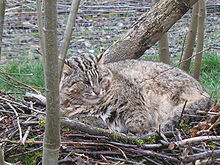Prionailurus bengalensis bengalensis
| Leopard cat | |
|---|---|
 |
|
| Indian leopard cat (P. b. bengalensis) | |
 |
|
| Amur leopard cat (P. b. euptilura) both at the Parc des Félins |
|
| Scientific classification | |
| Kingdom: | Animalia |
| Phylum: | Chordata |
| Class: | Mammalia |
| Order: | Carnivora |
| Suborder: | Feliformia |
| Family: | Felidae |
| Genus: | Prionailurus |
| Species: | P. bengalensis |
| Binomial name | |
|
Prionailurus bengalensis (Kerr, 1792) |
|
 |
|
| Leopard cat range | |
The leopard cat (Prionailurus bengalensis) is a small wild cat native to continental South, Southeast and East Asia. Since 2002 it has been listed as Least Concern on the IUCN Red List as it is widely distributed but threatened by habitat loss and hunting in parts of its range.
Historically, the leopard cat of continental Asia and of the Sundaland islands was considered a single species. As of 2017, the leopard cat occurring in the Sundaland is recognised as a distinct species, Prionailurus javanensis.
Leopard cat subspecies differ widely in fur colour, tail length, skull shape and size of carnassials. Archaeological evidence from China indicates that the leopard cat was the first cat species to be domesticated, earlier than 3000 BC, prior to being supplanted in favour of the wildcat after the end of the Neolithic.
A leopard cat is about the size of a domestic cat, but more slender, with longer legs and well-defined webs between its toes. Its small head is marked with two prominent dark stripes and a short and narrow white muzzle. There are two dark stripes running from the eyes to the ears, and smaller white streaks running from the eyes to the nose. The backs of its moderately long and rounded ears are black with central white spots. Body and limbs are marked with black spots of varying size and color, and along its back are two to four rows of elongated spots. The tail is about half the size of its head-body length and is spotted with a few indistinct rings near the black tip. The background color of the spotted fur is tawny, with a white chest and belly. However, in their huge range, they vary so much in coloration and size of spots as well as in body size and weight that initially they were thought to be several different species. The fur color is yellowish brown in the southern populations, but pale silver-grey in the northern ones. The black markings may be spotted, rosetted, or may even form dotted streaks, depending on subspecies. In the tropics, leopard cats weigh 0.55 to 3.8 kg (1.2 to 8.4 lb), have head-body lengths of 38.8 to 66 cm (15.3 to 26.0 in), with long 17.2 to 31 cm (6.8 to 12.2 in) tails. In northern China and Siberia, they weigh up to 7.1 kg (16 lb), and have head-body lengths of up to 75 cm (30 in); generally, they put on weight before winter and become thinner until spring. Shoulder height is about 41 cm (16 in).
...
Wikipedia

